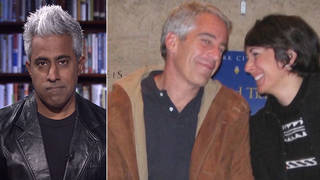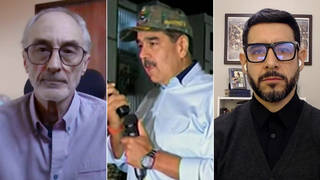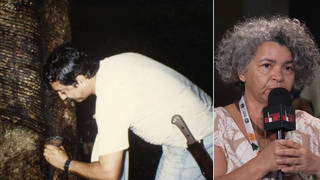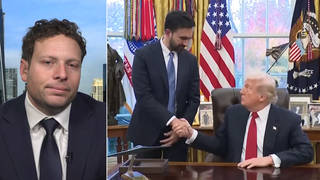
Guests
- Jane McAleveyunion organizer, negotiator and scholar who is currently a senior policy fellow at UC Berkeley’s Labor Center.
Labor organizer and scholar Jane McAlevey says there were many warning signs that the historic Amazon union drive in Bessemer, Alabama, would fail. Workers at the Amazon warehouse voted overwhelmingly against forming a union after a months-long vote by mail, with Amazon using widespread intimidation and misinformation to undermine the effort. But McAlevey says organizers made a number of missteps in their campaign and didn’t do enough to engage workers in the warehouse. “There’s a strategy and a method for every part of a hard campaign. Do we always win when we follow them? No. Do we stand a better chance of winning them? Yes,” says McAlevey.
Transcript
AMY GOODMAN: Next up, we turn to Jane McAlevey, a longtime union organizer whose piece in The Nation is headlined “Blowout in Bessemer: A Postmortem on the Amazon Campaign.”
Jane, if you could start off by talking about, from your perch at UC Berkeley’s Labor Center — you’re author of a number of books on labor — by talking about what you see happened?
JANE McALEVEY: Sure. Thanks for having me here today.
First thing I want to do, actually, is salute to every single worker at the Bessemer plant for the bravery and the courage that they exercised in the campaign, and I hope that they wind up having a union soon.
But I want to redirect it from my perch at UC Berkeley Labor to my years as an organizer — decades, actually, as a union organizer. And I still do organizing. What I saw were several things from the very beginning. And I outlined them in the article in The Nation.
The first was what we call a really inaccurate list, sort of the gap between how many workers actually work in the facility and how many workers the union thought worked in the facility, and then — and then, of course, the employer stacked it.
Let me also just say, I believe they will get a rerun election in that plant, because Amazon violated the law left, right and center. That, there’s no question we need the PRO Act. There’s no question Amazon and Jeff Bezos — Bezos needs to pay a lot of taxes, Amazon needs to be unionized, and I’m looking forward to it.
But we know, in really hard elections, which I’ve had the pleasure of running and helping workers win, many times, going up against very profoundly serious union busters, there are a series of steps that we have to take in order for the workers to stand a chance. And one of them, ironically, is the one that Stuart Appelbaum just mentioned at the end of the interview, which is developing majority support, which I write about in the article.
So, you could analyze that from the period when they surfaced the campaign, which was October 20th at the plant gates, straight through to when they filed for the election, which was in November, they were informed at that time that they were off by several thousand workers in the assumption about how many workers worked at the plant. And I’m not saying — you know, there should be no mystery. They should be given a list. If workers want to form a union, why doesn’t the employer have to give us a list? But they don’t, because they’re not fair, just like they’re not fair in Georgia. So, if you deal with the reality that these are outrageously unfair conditions, what are the steps you have to take to try to win?
So, if I was on the ground in Amazon, I would have tried to, instead of getting simply majority card signatures between November 20th, or the date that they were informed that they were really off on the numbers, and December 20th, was the hearing date. You would want to be judging right then: Could you get a majority of those workers to publicly commit to vote to support the union? It’s called a vote yes petition. It’s called a structure test. It’s a normal thing that union organizers do in hard campaigns, and I’ve had to do many of them with workers, because we know once the employer campaign gets off the ground, it’s going to erode a ton of support.
So, when I was trained to be a union organizer when I was very young, by a union called 1199, I was trained to file with no less than 75% of the workers on membership cards — not 30%, not 40%, not even 55%. We assume 25% of our vote is going to be shaved by aggressive union busters.
When it comes to the captive audience meetings, like, of course they’re doing captive audience meetings. I’ve had workers dragged — in hospital campaigns, I’ve had nurses dragged away from a patient into a captive audience meeting, pleading to let the union buster let her finish a procedure during an operation with a patient and been dragged into a captive audience meeting.
So, what’s our approach to captive audience meetings? Ours is, in the campaign I’m describing to you, which was 2006, in a right-to-work state — ours was we printed out — we made beautiful tickets that looked just like movie tickets, like you would get a ticket to go into a movie theater, when we can go back into them. We printed movie tickets. We bought popcorn. We bought microwave bags of popcorn. Every nurse in the hospital had access to a break room. We said, “You need to go in en masse.” We made a plan with the workers for how to approach the captive audience meeting, which was take a ticket, circulate it, take the popcorn, make the popcorn loud, go into the captive audience meeting and have a hundred nurses chewing popcorn as loudly as you can, and then get up and say it’s time to go back to your patients.
Like, there’s a strategy and a method for every part of a hard campaign. Do we always win when we follow them? No. Do we stand a better chance of winning them? Yes. One of the things I talked about in the campaign was, you know, working a plant gate strategy. You can’t win at a plant gate strategy with a normal company, let alone one known for its surveillance, because workers will be too scared to talk to you.
So, a fundamental of hard campaigns is about building majority support going into the election, knowing the workers are ready to stand up to union busters. And you have to do that by house calling. You have to knock on the door unannounced for every single worker on that campaign. And they’re going to be really hard conversations, because people are polarized and scared.
But there are methods for how we win hard-to-win union campaigns. Kate Bronfenbrenner wrote about them. She’s now at Cornell. She was a union organizer who’s now at Cornell’s labor institute. She’s written for decades about the methods. There are methods, and we need to follow them. And I wrote my article for the future Amazon workers who are going to try and win their campaigns, with the hope that they stand a better chance, because we need Amazon organized yesterday.
AMY GOODMAN: Now, you were saying early on that you thought that the union was going down in flames in Bessemer. What were the indications to you?
JANE McALEVEY: Yeah, the first one, which was the inaccuracy of the list — right? — the sort of gap between when they filed for the election in November, on 1,500 workers — that’s 1,500 workers — versus when they got to the hearing in December, and it was clear that there were 5,800 workers. Did Amazon stuff the numbers? Probably. They have in every election I’ve been involved in.
But when I go to a hearing like that, when I’m at the labor board hearing and we’ve got workers with us and we’re debating with the employer what’s going to happen, you know, right there, there was very big trouble. And every organizer I know, have trained, who trained me, and I work with, were all immediately emailing each other, saying, “This is big trouble, and we’re really worried about it.” So, from December on, I think there were a series of concerns that people who have run against hard union busters had about this campaign. And we wished that it had a different outcome.
And I wish that my article was never in The Nation magazine. The truth is, I wrote it for Amazon workers. And I’ve had Amazon workers in trainings, and I hope to have more Amazon workers in trainings, right? I work with and teach people how to win hard campaigns, because there are things that we know that you have to do.
Another one I mentioned, which is this whole discussion which just surfaced again, about how do you talk about dues. The first thing the employer does, in campaigns I’ve run, is actually put out food on the table and show workers — or, like, you know, radios or things that you could buy for the equivalent of the dues. This is standard operating procedure, and why we need the PRO Act, desperately why we need the PRO Act. Everything I’m saying is why we need the PRO Act.
But as an organizer, I’m also saying we have to give workers the best shot humanly possible in the conditions under which we currently work. Stacey Abrams made that case beautifully in The New York Times about how they won the two Senate races in Georgia. It wasn’t just folks just showed up there and took like an approach to talk to everyone who agreed with them. They went on the doors, masks on. You know, she wrote a centerpiece in The New York Times about how to win a hard campaign. It’s very similar, actually.
AMY GOODMAN: Jane, we have 20 seconds. The final comments on what you think has to happen next?
JANE McALEVEY: First of all, I think a lot of unions have to collaborate on this, for sure. I don’t think trying to run a straight National Labor Relations Board election process is the way to go with Amazon. So, whether it’s what the Teamsters are going to do — you can do what’s called a strike for recognition, under U.S. labor law. You can actually walk out and demand recognition and demand your employer recognize you. We used to do more of that, but that takes building supermajority support.
So, what I hope is that Amazon workers look at the lessons from Bessemer, regroup, that unions actually put together a serious plan to take on them, Uber, Lyft, Silicon Valley and every one of those companies that is literally destroying the lives of workers in this country and desperately need to be unionized. We need to give the workers a fair shot when we go after Amazon.
AMY GOODMAN: Jane McAlevey, we want to thank you for being with us, union organizer, negotiator, scholar, currently senior policy fellow at UC Berkeley’s Labor Center. Her recent piece, we’ll link to, in The Nation, “Blowout in Bessemer: A Postmortem on the Amazon Campaign.”
Next up, we remember the lives of Ramsey Clark, the former U.S. attorney general, and LaDonna Brave Bull Allard, Native American historian of the Standing Rock Sioux. Stay with us.











Media Options